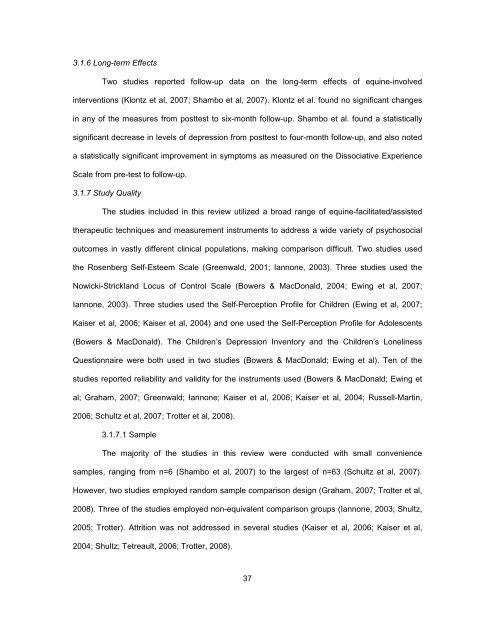A SYSTEMATIC REVIEW OF THE EFFECTS OF PSYCHOTHERAPY ...
A SYSTEMATIC REVIEW OF THE EFFECTS OF PSYCHOTHERAPY ...
A SYSTEMATIC REVIEW OF THE EFFECTS OF PSYCHOTHERAPY ...
Create successful ePaper yourself
Turn your PDF publications into a flip-book with our unique Google optimized e-Paper software.
3.1.6 Long-term Effects<br />
Two studies reported follow-up data on the long-term effects of equine-involved<br />
interventions (Klontz et al, 2007; Shambo et al, 2007). Klontz et al. found no significant changes<br />
in any of the measures from posttest to six-month follow-up. Shambo et al. found a statistically<br />
significant decrease in levels of depression from posttest to four-month follow-up, and also noted<br />
a statistically significant improvement in symptoms as measured on the Dissociative Experience<br />
Scale from pre-test to follow-up.<br />
3.1.7 Study Quality<br />
The studies included in this review utilized a broad range of equine-facilitated/assisted<br />
therapeutic techniques and measurement instruments to address a wide variety of psychosocial<br />
outcomes in vastly different clinical populations, making comparison difficult. Two studies used<br />
the Rosenberg Self-Esteem Scale (Greenwald, 2001; Iannone, 2003). Three studies used the<br />
Nowicki-Strickland Locus of Control Scale (Bowers & MacDonald, 2004; Ewing et al, 2007;<br />
Iannone, 2003). Three studies used the Self-Perception Profile for Children (Ewing et al, 2007;<br />
Kaiser et al, 2006; Kaiser et al, 2004) and one used the Self-Perception Profile for Adolescents<br />
(Bowers & MacDonald). The Children’s Depression Inventory and the Children’s Loneliness<br />
Questionnaire were both used in two studies (Bowers & MacDonald; Ewing et al). Ten of the<br />
studies reported reliability and validity for the instruments used (Bowers & MacDonald; Ewing et<br />
al; Graham, 2007; Greenwald; Iannone; Kaiser et al, 2006; Kaiser et al, 2004; Russell-Martin,<br />
2006; Schultz et al, 2007; Trotter et al, 2008).<br />
3.1.7.1 Sample<br />
The majority of the studies in this review were conducted with small convenience<br />
samples, ranging from n=6 (Shambo et al, 2007) to the largest of n=63 (Schultz et al, 2007).<br />
However, two studies employed random sample comparison design (Graham, 2007; Trotter et al,<br />
2008). Three of the studies employed non-equivalent comparison groups (Iannone, 2003; Shultz,<br />
2005; Trotter). Attrition was not addressed in several studies (Kaiser et al, 2006; Kaiser et al,<br />
2004; Shultz; Tetreault, 2006; Trotter, 2008).<br />
37
















